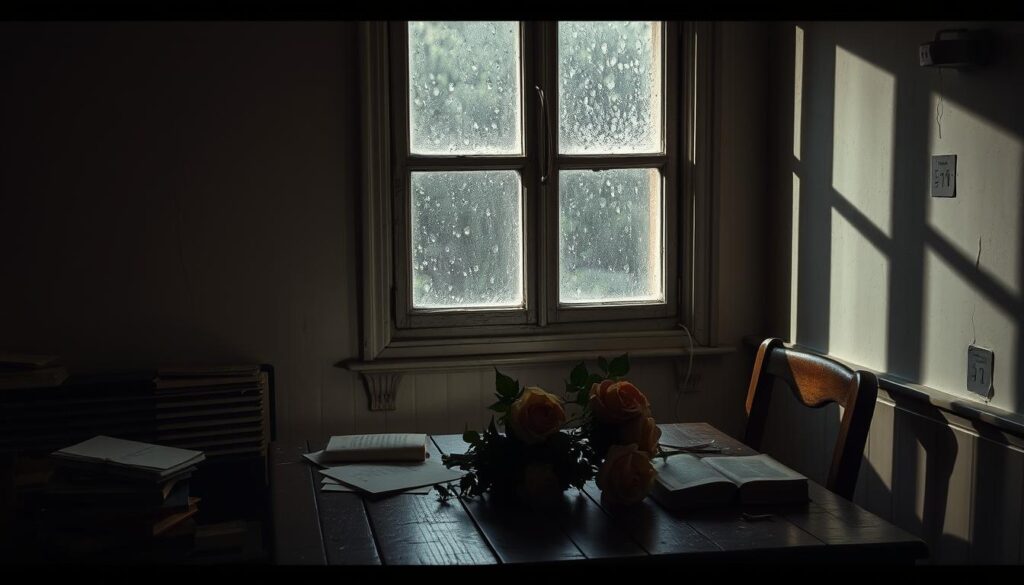Tragic romance writing is a special art. It mixes sorrow and love in a way that grabs readers. These stories make us feel deeply, long after we finish reading.
To get good at it, you need to know how to balance the story. You must mix heartache and passion in a real and touching way.
At the core of writing tragic romances is connecting with readers. You do this by making characters and relationships complex. Also, the setting should add to the mood.
By focusing on these, you can create stories that touch and stay with readers.
In this article, we’ll explore the details of writing tragic romances. We’ll share tips and insights to help you write compelling stories. We’ll cover character development, symbolism, and more. Each part will offer valuable advice for evoking emotion and mastering the art of tragic romance.
Understanding the Appeal of Tragic Romances
Tragic romances grab readers in a special way. They touch hearts with emotional stories that feel real. The mix of love and loss is something we all know.
These stories connect us deeply with the characters. We feel their emotions as if we’re part of the story.
People love powerful romantic narratives because they show love’s true side. Tragic romances are like real life, where love is complex. Not every story ends happily.
This makes the stories feel real and deep. We know heartbreak is something we all face.
The emotional stories in tragic romances help us feel better. They let us share in the characters’ ups and downs. This connection makes the tragic love appeal so strong.
Creating Complex Characters
Making characters deep and real is key for a great tragic romance. They should feel real and make us feel for them. It’s important to mix character growth, emotional depth, and realistic flaws well.
Character Backstory
A good backstory is vital for character growth. It helps us see why they act and feel certain ways. This history adds layers to their story, making their struggles more touching.
Intricate Relationships
How characters relate to each other shapes the story. Complex relationships add depth and emotion. They show the real side of human connections and how they affect us.
Personal Flaws and Virtues
Characters’ flaws are as important as their good sides. These imperfections make them relatable and human. Mixing virtues with flaws creates moments of truth, leading to tragic but compelling stories.
Setting the Scene in a Tragic Romance
In tragic romances, the setting is key. It shapes the mood and feels of the story. Think of places that feel sad, nostalgic, and full of longing.
Maybe a misty riverside where lovers once met, or an old, broken-down house. These places can show lost dreams.
For example, a rainy cemetery at dusk is perfect. Its dark mood fits the story’s themes well. It lets readers feel the characters’ pain and sadness.
Settings should show what’s inside the characters’ minds too. A messy place can show their inner turmoil. A calm, yet empty spot can show peace and sadness together.
This careful use of setting makes the story more moving and interesting. It’s not just a background. It’s part of the story, affecting how readers feel and see things.
Building an Emotional Connection
To create a strong bond with characters, use evocative language and show their vulnerabilities. This mix of descriptive writing and true character emotions is key.
Using Descriptive Language
Descriptive language is vital for creating vivid scenes. It lets readers dive into the characters’ world. By painting detailed scenes, writers can stir strong emotions and connect readers deeply with characters.
Think about how rain feels on your skin or the smell of flowers. These details can set the mood and show a character’s feelings. This kind of language helps readers feel close to the characters’ experiences.
Showing Vulnerability
Showing a character’s vulnerability makes them more real and relatable. By sharing their fears and struggles, characters become more than just figures. Vulnerable moments, like confessions or mistakes, show a character’s true self.
When characters share their doubts and challenges, they open up to readers. This openness strengthens the bond between readers and characters. It makes the story more real and touching.
Crafting Melancholy: Tips for Writing Compelling Tragic Romances
Melancholic storytelling touches readers deeply, especially in tragic romances. It’s an art that mixes sorrow and love. To write a moving story, focus on key elements.

Feel the deep emotions in tragic romances. Characters with complex stories grab readers’ hearts. Show their good and bad sides to make them relatable.
A dark setting can make the story even more sad. It adds to the mood.
Use vivid images and words to connect with readers. Show your characters’ weak spots. This makes readers feel their pain.
How fast you tell the story matters. Slowly add tension to make the sad parts hit hard. Hint at what’s coming to keep readers interested.
Adding symbols and metaphors makes your story richer. Make sure your story feels real. Balance hope and sadness for a deep reading experience.
Be careful with sensitive topics in your tragic romance. Connect with your readers but avoid clichés. With careful thought, your story can be both moving and unforgettable.
Incorporating Symbolism and Metaphors
Symbolism and metaphors can make your tragic romance stand out. They add layers of meaning that touch readers’ hearts. By using these elements, authors can make the story richer and more engaging. Let’s see how to weave them into your settings and dialogue.
Symbolism in Settings
The setting of your story is more than a backdrop. It’s a canvas for symbolism to flourish. Think about using weather, landscapes, and objects to reflect your story’s themes. For example, a dying rose garden can symbolize a failing relationship. A stormy night might show inner turmoil.
These small touches of symbolism in romance make your story poetic. They engage readers on many levels.
Metaphors in Dialogue
Dialogue is a great place for metaphors to shine. Characters can share deep feelings and relationships through symbolic dialogue. For instance, saying love is like “fragile glass” shows vulnerability and the risk of heartbreak. Using metaphors makes your characters more expressive and connects readers to the story.
Learning to use symbolism and metaphors in your tragic romance can make it unforgettable. By adding these elements to your settings and dialogue, you create a story full of meaning. Readers will appreciate and remember it.
Pacing Your Story’s Tragic Elements
Mastering the pace of tragic stories is key to keeping readers hooked. It’s about matching the story’s rhythm with the intense feelings of tragic romances. This way, each big moment is timed perfectly to build suspense without stressing the audience too much.
Spreading out key moments in the story is a smart move. It lets emotions build up slowly, keeping the story’s rhythm steady. It’s like a symphony where each part comes in at the perfect time.
Also, adding moments of calm and humor helps. It gives readers a break from the tragedy. This balanced approach keeps the story engaging and relatable, making readers care about the characters.
Creating suspense is all about using foreshadowing and hints. These keep readers guessing and eager for more. It’s about making each scene more exciting and emotionally deep, making readers want to keep reading.
With careful planning, you can make a story that grabs and touches readers. It’s the essence of tragic romances.
Developing Heart-wrenching Conflicts
Creating conflicts that touch our hearts means looking at what characters face inside and out. These parts make the story real and feel deep.
Internal Conflicts
Internal struggles go to a character’s deepest fears and desires. For example, a hero might feel guilty about something in the past. Or they might fear losing someone they love. These feelings guide their choices and actions.
These inner battles make the story richer and more complex. They add to the romantic conflicts in the tale.
External Conflicts
External conflicts come from outside the character, like society’s rules or enemies. These challenges test the characters’ bonds, bringing drama and tension. Mixing these outside forces with personal struggles raises the stakes and feelings.
Conflict Resolution
It’s key to wrap up the story in a way that feels right. This ending should match the story’s themes, whether it’s a hard choice or a big sacrifice. A well-thought-out ending wraps up the characters’ stories and moves the audience.
Creating a Realistic Plotline
Making a plotline that feels real is key to writing romance stories that readers love. It’s all about finding the right mix of facts and feelings. This mix makes the story both moving and easy to connect with.
Letting characters lead the story is a great tip. Their actions should match who they are and what they’ve been through. This makes the romance seem real and true.
Adding small, everyday moments is also important. These moments make the story feel more real. They could be a quiet chat over coffee or a small fight. These details help make the romance believable.
It’s also important to show the not-so-perfect parts of love. Love isn’t always easy; it has ups and downs. Including these parts makes the story more real and touching.
In the end, a good plotline is about mixing facts with feelings. This mix makes the story’s sad parts hit hard and the romance feel real. It keeps readers fully into the story.
Foreshadowing Tragic Outcomes
Foreshadowing in writing is key to hinting at tragic events in your story. It’s about giving hints without revealing too much. This keeps the story exciting and full of surprises.
Subtle Hints
Subtle hints can be found in many ways. A small comment might mean a lot later. Or, details in the setting might hint at future sadness. The trick is to give just enough to keep readers curious.
Building Tension
Building tension in romance stories keeps readers hooked. By adding hints slowly, readers start to feel the tragedy coming. This suspense makes the story more emotional and satisfying.

Writing Powerful Dialogue
Dialogue is key in romance, making characters come alive. It’s what makes every word matter. Good conversations bring characters closer to each other and to us.
Reflecting Character’s Inner Thoughts
Characters’ thoughts can show in their words, giving us a peek into their feelings. This shows their struggles and makes them more real. It makes their story deeper and more touching.
Adding Layers to Relationships
Good dialogue does more than just show what’s happening. It digs into feelings and the little things between characters. This makes their bond stronger and their story more emotional.
Balancing Hope and Despair
In a tragic romance, mixing hope with despair is key. This balance keeps the story engaging. It stops the tale from feeling too dark.
When adding hope to tragedy, show light in the dark. This balance is crucial. It keeps readers caring about the characters’ stories.
Hope gives a break from the darkness. It offers a chance for characters and readers to feel hopeful again. These brief moments make the story’s sadness more impactful.
Placing hope in the story connects readers to characters. Seeing characters overcome big challenges shows their strength. This makes them more relatable.
Hope and despair together touch our hearts deeply. They make the story’s sad parts more meaningful. This way, the story stays with us long after we finish reading.
Handling Sensitive Themes with Care
When we talk about sensitive themes in tragic romances, we must be careful. We need to understand our audience well. This way, we can handle these themes with respect and care.
Staying away from romance clichés is key. It keeps our story unique and real. This makes it more relatable and powerful for our readers.
Understanding Your Audience
Knowing who we’re writing for is crucial in tragic romances. We must research and get to know our readers’ expectations and values. This helps us create a story that touches them personally.
By considering these things, we can write in a way that is both respectful and engaging. This makes our story more meaningful and impactful.
Avoiding Clichés
It’s important to avoid romance clichés to make our tragedy original and captivating. Common clichés can make our story feel predictable and fake. Instead, we should aim to create fresh and nuanced situations.
This approach adds depth to our narrative. It also keeps our readers interested and emotionally connected throughout the story.
The Role of Side Characters in Tragic Romances
In tragic romances, side characters are key. They add depth and emotion to the story. While the main characters grab our attention, side characters bring complexity and realism.
Side characters can contrast with the main ones. They show the main characters’ struggles and dreams. These characters also add humor, making the sad parts more touching.
Side character development is vital. It makes the tragic parts more impactful. Writers create deep backstories and motivations for these characters. This adds layers to the story, making every character important.
In short, side characters are crucial in tragic romances. They make the story richer and the tragedy more powerful. Their development adds to the emotional impact, making the story unforgettable.
Utilizing Imagery to Convey Melancholy
Visual elements are key in creating scenes that touch our hearts. They make the sadness in tragic romances stand out. Pictures of the setting and characters can pull readers into the story’s sorrow.
Details are important for setting the mood. A fading sunset, wilting flowers, or an empty street can show the characters’ sadness. These images make the story’s tragedy feel stronger.
Using these details well in your story adds to the sadness. When readers see and feel the characters’ pain, they connect deeply with them. This makes the story’s emotional impact even more powerful.
To master imagery in tragic romances, mix careful details with strong images. Each one should work together to pull readers into the story’s emotional world.
Ending on a Powerful Note
In tragic romances, a strong ending is key. As your story ends, focus on how it touches the reader’s heart. Good endings make us feel deeply, through tears or a mix of sadness and hope.
Stay true to your characters’ paths. The ending should feel like a natural end, not forced. Give your audience the satisfaction they’ve been waiting for. This might mean accepting the sadness of the story.
Also, add a bit of hope or strength, even in the dark. This makes your ending even more touching. A small glimmer of light can make your story feel complete and lasting. The aim is to leave a lasting impression on your readers.



